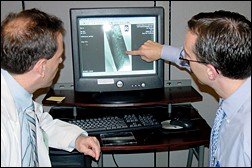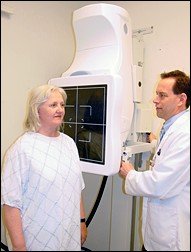In 2003, Life Chiropractic College West became the first chiropractic educational program in the world to begin a conversion from film-based radiography to computed radiography (CR).
[For background information, please see www.chiroweb.com/archives/21/19/11.html and www.chiroweb.com/archives/22/02/04.html.] On May 6, 2006, an agreement was finalized between the college and HCMI, Inc., to take the college to the next level of X-ray imaging with the installation of a direct digital (DR) radiography system in the Life Chiropractic College West Health Center.
 "Life West is thrilled to offer our students and the profession a facility that will utilize traditional film-based radiography, computed radiography and digital radiography" remarked Life West President Gerard W. Clum, DC. "Life West continues to be the worldwide leader in the application of digital imaging technologies in chiropractic education."
"Life West is thrilled to offer our students and the profession a facility that will utilize traditional film-based radiography, computed radiography and digital radiography" remarked Life West President Gerard W. Clum, DC. "Life West continues to be the worldwide leader in the application of digital imaging technologies in chiropractic education."
"HCMI is honored to have the opportunity to work with the chiropractic profession's leader in digital X-ray imaging - Life Chiropractic College West. We are pleased to help bring Life West to the next level in the evolution of X-ray imaging technology," added Jay McElhannon, vice president of HCMI, Inc.
HCMI, a wholly owned subsidiary of Summit Industries, has been serving the chiropractic profession's equipment needs for more than 19 years. The development of an affordable digital imaging system for the chiropractic profession is the realization of a long-held corporate goal of HCMI.
Computed radiography, or indirect digital imaging, requires the use of a digital recording media that is placed within a cassette in the same fashion as film. Once exposed, the cassette is opened, the digital media card removed and passed through a reader system, and for a 14"x17" card, the image is available on a monitor in less than one minute. Direct digital imaging, or direct-capture imaging, exposes a digital system in the bucky and the image appears on the computer monitor in six to eight seconds. There are no cassettes, no digital media cards and no intermediate steps.
"The advantages of computed and digital imaging are dramatic; the speed and ease of digital imaging make it the preferred system in radiology, without question," observed Dr. Clum. "We continue to expose our students to film-based radiography, computed radiography and direct digital radiography so that they will be prepared to enter practice using any of the three methods, and they will also be prepared to upgrade to the next level as their circumstances permit."
The costs of computed radiography systems and digital radiography systems have dropped dramatically over the past five years. Computed radiography "retrofit systems," using an existing X-ray machine and bucky configuration, now run in the low $30,000 range and complete direct digital radiography systems now run in the mid-$70,000 range, while the direct digital upgrades start in the mid-$50,000 range. The advantages to these systems, economically and clinically make the investment needed to transition immediate and obvious.
"Once you convert to computed radiography or direct digital radiography, you have bought your last box of film, had your last processor cleaning and the last chemical changes in your career," said Dr. Clum. "When the efficiencies of image storage, retrieval, copying, patient presentation, etc., are considered film-based radiography looks foolish."
 The absolutely ideal situation in which to consider the implementation of this technology is when a chiropractor is building a new office or remodeling an existing office. Imagine not having the design and construction costs associated with electrical and plumbing related to a darkroom and the space allocated to film storage, as well as not having the initial expense and ongoing expense of an X-ray processor and the ability to avoid future requirements for capture of waste water used in film processing. Considering all of these factors, the acquisition of a digital imaging system is not only affordable, but also saves money.
The absolutely ideal situation in which to consider the implementation of this technology is when a chiropractor is building a new office or remodeling an existing office. Imagine not having the design and construction costs associated with electrical and plumbing related to a darkroom and the space allocated to film storage, as well as not having the initial expense and ongoing expense of an X-ray processor and the ability to avoid future requirements for capture of waste water used in film processing. Considering all of these factors, the acquisition of a digital imaging system is not only affordable, but also saves money.
"When these economic advantages are combined with the lowered dose of radiation used in digital systems and the increased clinical utility of digital images, a decision to move in the direction of digital imaging is obvious," observed Dr. Clum.
For chiropractors considering the jump away from film, the Health Center at Life West is open to see a system in operation, to speak with our faculty and interns about the use of the system and to familiarize themselves with what practice could be like for them with computed radiography or digital radiography. To schedule a visit to the campus, contact Dr. Pam Adams (510-780-4500, ext. 2402; ). The college has developed a two-hour continuing education model on advances in imaging in chiropractic that includes a comprehensive overview of this technology. To schedule the offering of this program at county or state association meetings or to other groups as desired, please call Dr. Kendra Holloway (510-780-4500, ext. 2030) or e-mail her at .
Dr. Gerry Clum served as president of Life Chiropractic College West for 30 years. He also is a former founding board member and president of the Association of Chiropractic Colleges and World Federation of Chiropractic. Currently, he is a member of the executive committee of the Foundation for Chiropractic Progress.




